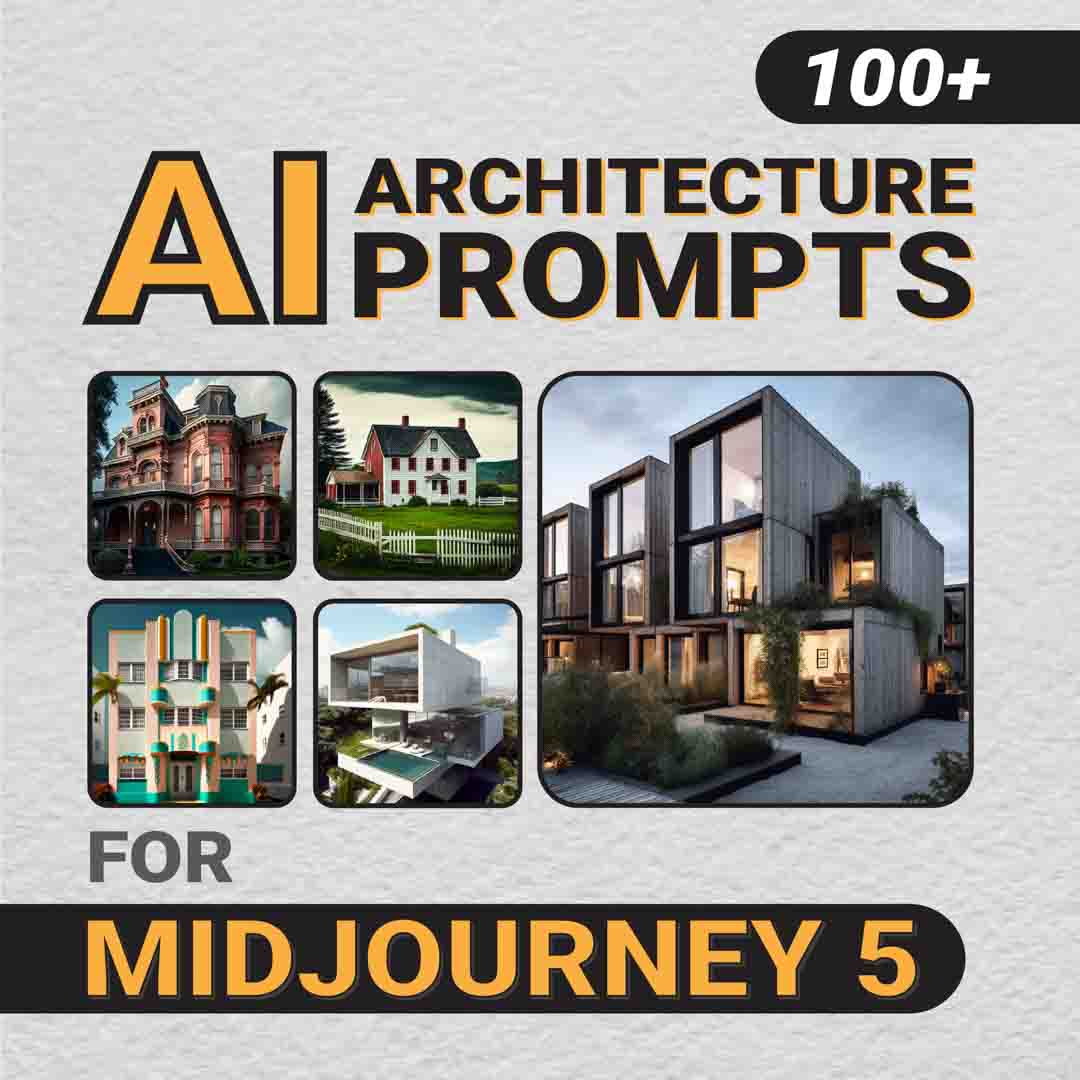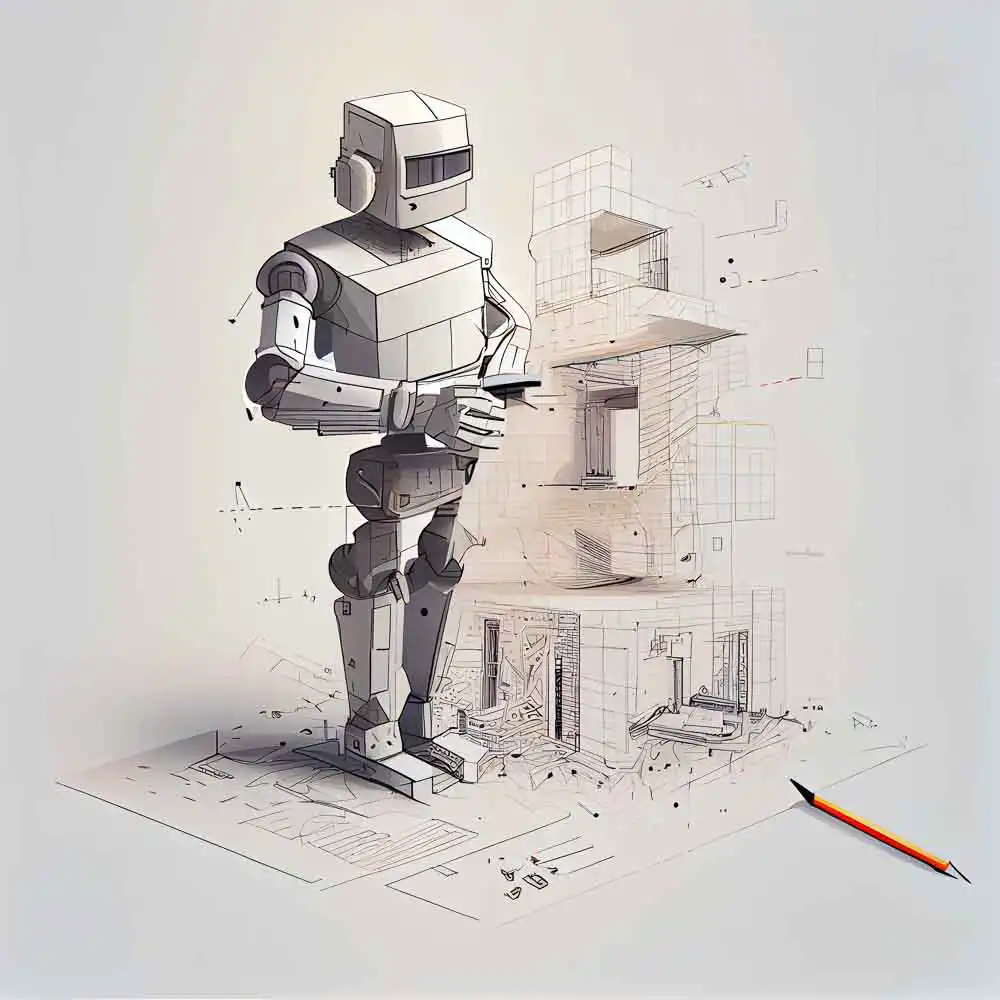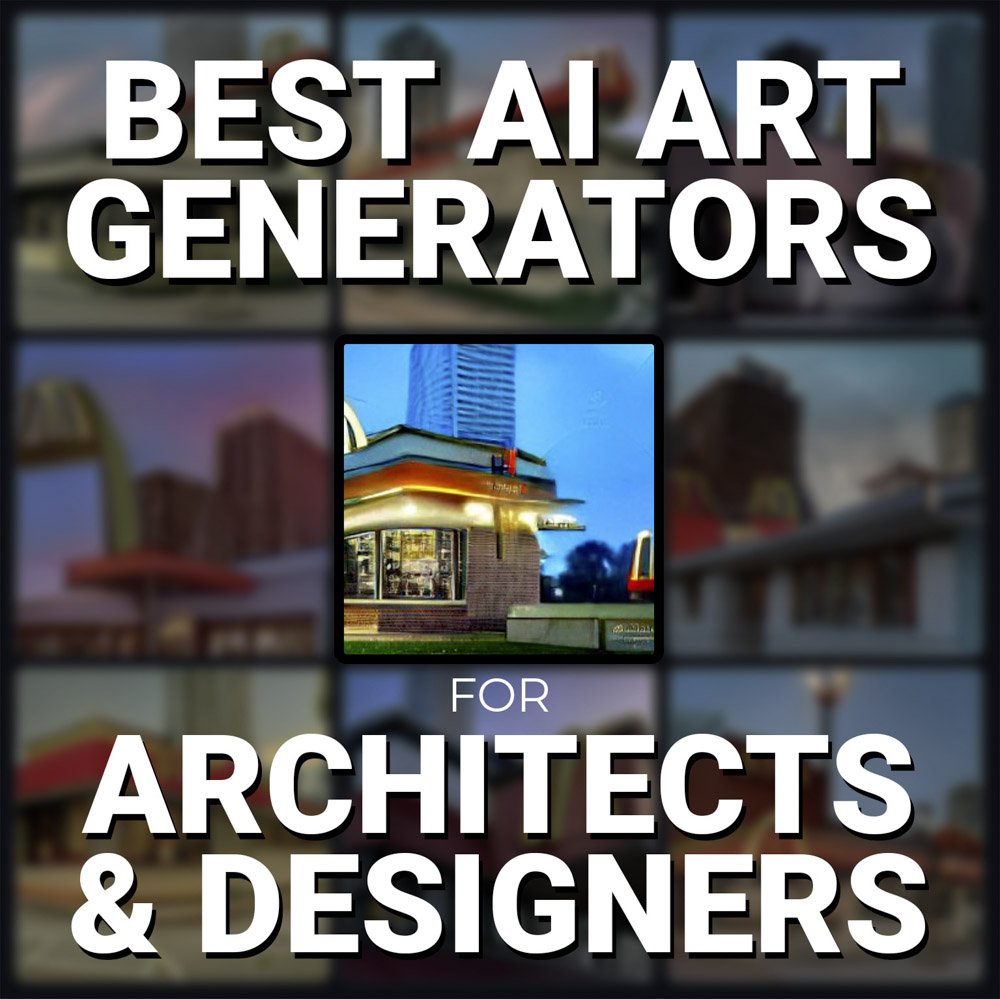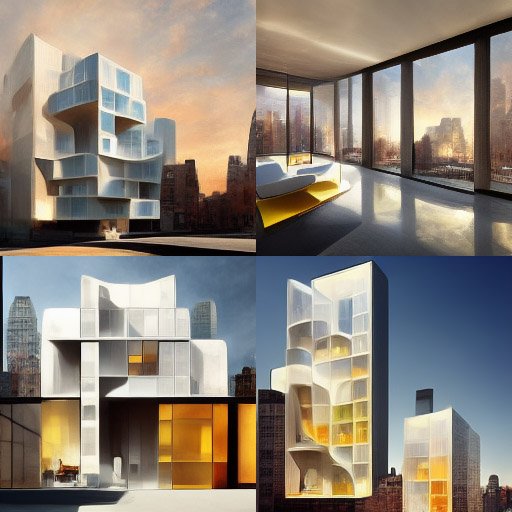The architectural design process is somewhat linear, yet there are a TON of opportunities in which architects can use AI. Many architects are already taking advantage of this groundbreaking technology in their design processes, using text-to-image generators and AI rendering plugins.
With new AI tools like MidJourney, Dall-E, and ChatGPT, there are more opportunities than ever for architects to start using AI in the design process — and integrating AI in the architectural design process is easier than ever.
Not only will AI increase architectural design efficiency, but AI tools for architecture can assist with mundane tasks in the design process — such as design prototyping, risk management, and cost control. If you’re interested to see how you can easily integrate AI in 6 Phases of the Architectural Design Process, read on!
To start, let’s cover the basics.
The architectural design process is an iterative process, meaning that it may involve going back and forth between different stages as new information is gathered or changes are made to the design.
In the image below, I’ve identified 6 phases of the design process in architecture:
6 Phases of the Architectural Design Process
So, how can architects integrate AI into the architectural design process?
To answer that, first we’ll need to take a look at what is currently available in terms of AI software.
I’ve written a bunch of posts on AI in architecture already, but you should definitely check out this post as a primer for what we’re going to discuss here:
It’s important to understand the implications of using AI in the design process. As architects and designers, we need to hold ourselves accountable to understand the design process for better results when integrating AI. There are a lot of different types of AI software being developed for architectural design, and not all of them are actually useful… or worse, they are not ethical (which I cover in the article above).
With that being said, you can rest assured that the software that I review on this website has been tested and reviewed thoroughly by myself and a variety of architecture and design communities.

7+ Best AI Tools for Architecture, Interior Design, and Urban Planning
With the latest AI tools and technology, you’ll stay ahead of the curve in the ever-evolving field of design. So why wait? Start using AI for architecture, interior design, and urban planning today and see the difference for yourself!
Many of these AI tools function in similar ways, but I’ve tried to distill the list down to the best AI software for architects that is currently on the market.
As AI and deep learning continue to rapidly evolve, the list above will likely change — so be sure to subscribe to my newsletter if you’d like to stay on top of the latest technology trends for architects and designers!
Below, I’ve listed the potential ways architects could use AI in the architectural design process.
How to Integrate AI in 6 Phases of the Architectural Design Process
This study showcases some examples of how AI could be integrated into the design process based o standard tools and software architects currently use in 2023.
As AI continues to rapidly evolve, the use cases could expand exponentially for architecture and design.
Phase 1: Pre-Design (PD)
The pre-design phase in architecture is the first stage of the architectural design process. It involves defining the project and gathering information about the site and the needs of the building’s users. Initially, architects, designers, and their clients are expected to establish project goals, identify stakeholders, develop a budget, create a program, and identify regulatory requirements.
Ultimately, the pre-design phase sets the foundation for the entire project.
AI Uses in Pre-Design
Program Analysis: One way AI can be used in architectural program analysis is through natural language processing (NLP) algorithms. These algorithms could be trained on a large dataset of architectural programs and used to analyze the contents of a given program.
An NLP algorithm could be used to identify the specific spaces and functions that are required in a building, as well as the relationships between these spaces. This information could inform the design process, helping architects ensure that the building meets the needs of its users and functions effectively.
AI could also be used to analyze the relationships between different architectural program elements and identify potential conflicts or inconsistencies.
For example, an AI system might be able to identify instances where the size or location of particular space conflicts with the requirements of a specific function or activity.
Pre-Design Phase: Viable AI Tools
- ChatGPT
- TestFit AI
Architectural Programming is the basis of design for any architecture project. Quite literally, it is a “playbook” by which designers and clients map out all of the goals, expectations and constraints that set up the architectural design.
The programming portion in the pre-design phase typically consists of creating preliminary design diagrams in conjunction with a healthy amount of number crunching, and AI could certainly be integrated to streamline this process.
Site Analysis: Test Fit AI
TestFit AI is a software tool for architects and building professionals. It uses artificial intelligence to generate floor plans and building designs, optimizing for specific requirements such as square footage, zoning, and building codes.
TestFit AI allows users to quickly test different design options and make informed decisions about building layouts, making the design process faster, more efficient, and more effective. The tool provides real-time feedback and analysis on design options, helping users to make better decisions about building configurations, unit mix, and other key aspects of building design.
Here’s an example of a quick site analysis that I created using TestFit AI:
To take the programming phase to the next level, be sure to check out this post on how to use AI for Architectural Programming:
All in all, the pre-design phase is vital for setting up a project. Although many parts of the programming phase are somewhat tedious or repetitive, utilizing the AI software above will make the process more efficient. Ultimately, AI can allow architects and designers to focus on more critical parts of the design process.
Moving into the next phase of the design process, let’s take a look at Schematic Design and how AI can be integrated.
Phase 2: Schematic Design (SD)
The schematic design phase of architecture is the second stage of the architectural design process. It involves developing concepts for the building’s layout, form, and function. During the schematic design phase, expectations include generating design options, evaluating precedents and existing designs, refining the design, and creating a basic set of drawings to show what the building might look like and how it will function.
The client should be very involved in this project phase as the design takes shape and form.
AI Uses in Schematic Design
Site Assessment: AI can be used to analyze a building site and gather data on factors such as topography, solar exposure, wind patterns, and proximity to amenities. This information can help architects make informed decisions about the design and orientation of a building.
Schematic Floor Plans: Generative design software is already capable of rapidly producing iterations of floor plans. Now, there’s potential for text-based AI software to be integrated into these generative design tools. For example, ChatGPT could be utilized to write code that could be integrated into generative design software.
Look and Feel Conversations (Concept Images): With software like MidJourney or Night Cafe, architects and designers have already begun utilizing AI to create design iterations based on text-based prompts. Take a look at this post to see some examples of how MidJourney can be used in architecture:
By creating detailed concept imagery early on the in the schematic design phase, architects and designers can relay their ideas more effectively to clients. This is important to create a basis for the overall aesthetic of the building. Additionally, using AI to create concept imagery helps facilitate decision-making about materials, light, color, and geometry early on in the design process.
Phase 3: Design Development (DD)
The design development phase of architecture is the third stage of the architectural design process. It involves creating more detailed and refined versions of the building design that was developed during the schematic design phase. During the DD phase, architects and designers will develop detailed plans, specify materials, and start integrating the schematic design into BIM software like Revit.
AI Uses in Design Development
Schematic Plan Development:
AI can be used to create architectural floor plans through the use of generative design algorithms. These algorithms can generate design options based on a set of input parameters, such as the size and shape of the building, the number and type of rooms, and the desired layout. The AI system can then evaluate the generated designs based on criteria such as efficiency, functionality, and aesthetics, and select the most promising options for further refinement.
One way to use AI for this purpose is to train a machine learning model on a large dataset of floor plans and their corresponding attributes (e.g., number of rooms, square footage). The model can then be used to generate new floor plans based on a set of input parameters.
Alternatively, AI algorithms can be used to optimize an existing floor plan by rearranging the layout of rooms and other features to improve efficiency or functionality. This can be done using techniques such as evolutionary algorithms or simulated annealing.
3D Modeling / BIM: AI can be used to create detailed 3D models of buildings and environments, which can help architects visualize and evaluate design options.
Phase 4: Planning Application
The planning and drawing review phase is a crucial stage in the architecture process, as it involves reviewing and approving the design plans for a building or construction project. During this phase, the architect will present the proposed design to the relevant authorities and stakeholders for review and approval. This may include the local planning department, building department, and any other agencies or organizations that have a vested interest in the project.
The purpose of this phase is to ensure that the proposed design meets all relevant regulations and codes, as well as the needs and requirements of the client. The architect may need to make revisions to the design based on feedback received during the review process.
AI Uses in Planning Application
Similar to other uses mentioned in the Pre-Design phase, text-based AI can help with virtual assistant tasks such as scheduling, managing emails and documents, and tracking project progress.
Phase 5: Construction Documentation (CD)
The construction document phase involves the production of detailed drawings and specifications that will be used to construct the building or project. These documents, also known as “working drawings,” provide all the information necessary for contractors and tradespeople to understand the design and build the project according to the architect’s vision.
The construction documents typically include floor plans, sections, elevations, and details that show the layout, size, and materials of each element of the building. They may also include specifications for the materials to be used, as well as information on electrical and mechanical systems.
During the construction document phase, the architect will work closely with engineers, contractors, and other professionals to ensure that the documents are complete and accurate. The documents will be reviewed and approved by the relevant authorities and stakeholders, and may be used to solicit bids from contractors. Once the construction documents are finalized, they serve as the basis for the construction of the project.
AI Uses in Construction Documents
Specification Writing: AI could be used to analyze data from past projects to identify patterns and make predictions about the requirements for future projects. This could help architects and engineers ensure that specifications are accurate and complete and save a ton of time.
Phase 6: Construction Administration (CA)
The construction administration phase is the final stage of the architecture process, and it involves overseeing the construction of the building or project to ensure that it is built according to the design plans and specifications.
During the construction administration phase, the architect will visit the construction site on a regular basis to monitor the progress of the work and ensure that it is being carried out according to the design plans and specifications. The architect will also review and approve shop drawings (detailed drawings of specific components of the project) and materials samples, and will attempt to resolve any issues or conflicts that may arise during construction.
Overall, the construction administration phase aims to ensure that the final project meets the design intent and the needs and requirements of the client.
AI Uses in Construction Administration
Punchlist Completion / Site Observations: AI can be used to analyze data from past projects to make predictions about the feasibility of a proposed project, such as the potential for construction delays or cost overruns.

Jon Henning
Hi, I'm Jon. I write about emerging technology in architecture, engineering and design, and I want to help you push boundaries with the latest tech trends in the AEC industry.
Want to step up your AI Architecture Visualizations? Grab a copy of my FREE eGuide, which contains over 100 examples of AI Architecture prompts to use with MidJourney 5.




